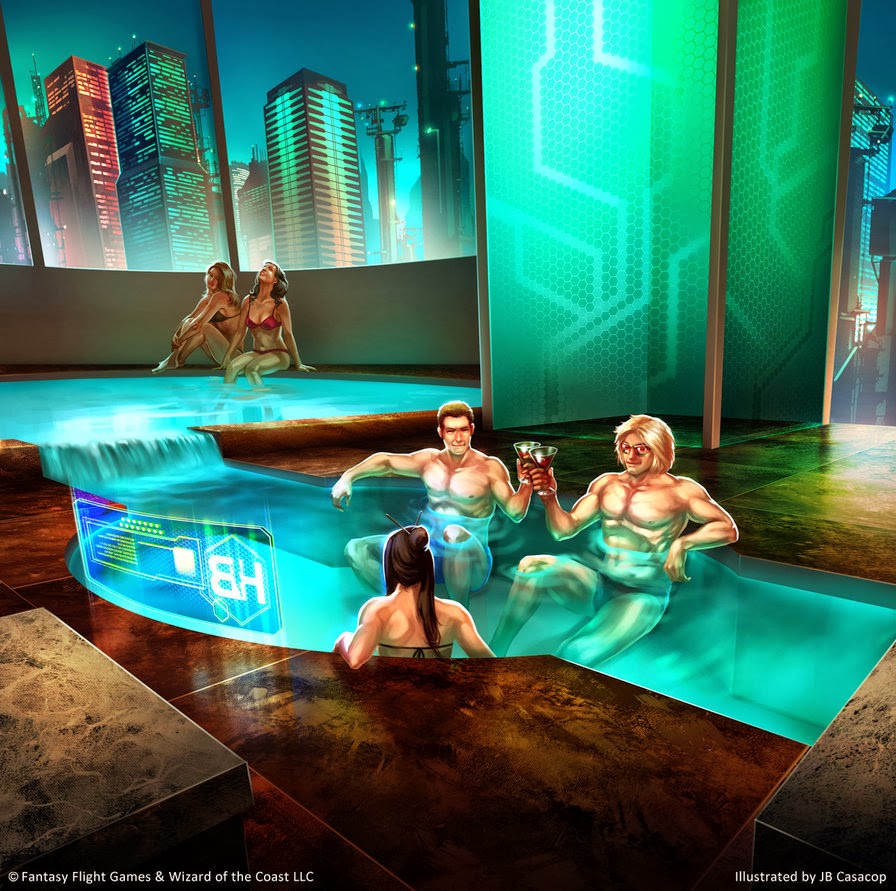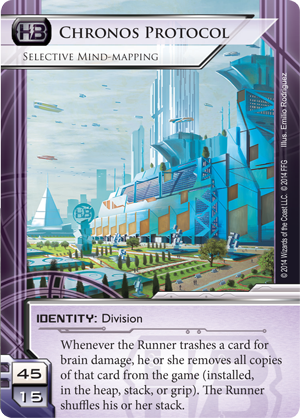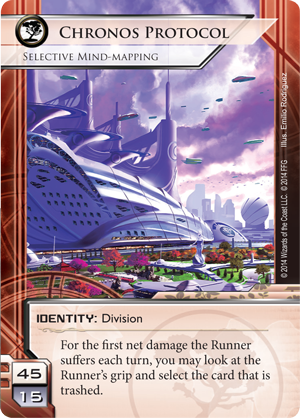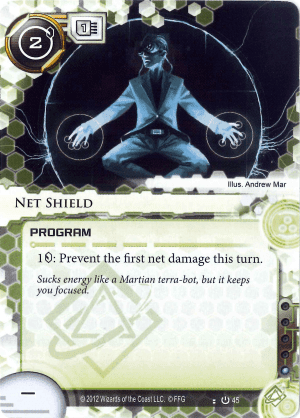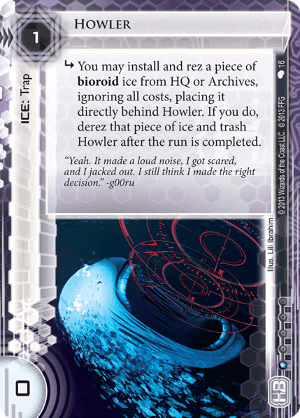Combinations or short: combos are very popular within all kinds of LCGs or TCGs. Players are literally digging through their archives of cards to figure out the next surprising, unexpected and effective combination. Whole evenings were wasted just checking if one card could be of use to support a certain type of deck.
Nobody will argue with me if I say that winning a game with a good combo will definitely makes you happy and you would feel vindicated.
But is it so simple? How complex should a combo be and what is the likelihood that you have enough time to prepare your combo if possible at all?
I will try to answer those questions in my next article and will provide with some advice how to set up your combinations. I will focus on common combos and spice it up with my own gaming experience. Please add a comment and tell us about your combos and experience for our favorite game.
Basics:
If we talk about combos we will have to set up a structure, otherwise you won't be able to follow at all. I may use the following groupings and I will refer back to them. Much more combos exist but it would be senseless to name every single of them because some are really bad. I will also add some statistics for you which will be similar to my previous articles (not yet available in English) because it's still about drawing cards and probabilities. So, what do we have?
1. ICE Combos
2. OPERATION Combos
3. ICE & ASSET Combos
4. OTHER Combos
Before I will go into more specific examples I wan't to show you some examples and calculations which should allow you to understand the whole probability thing in a better way. If you already know about all the mathematics or read my Mulligan posts please skip this part.
In every probability theory and especially card draw it comes down to a distribution model called hyper-geometric distribution. It describes the probability of k successes in n draws without replacement from a finite population which is very useful because we are drawing cards from our R&D so our population is the deck size. We can define the number of successes (the cards we want to see) and the overall successes in our deck (copies of cards in the deck).
It allows us to make some useful calculations. Only a few of them are possible to calculate without anything to write on and doing some mental math during a match. Therefore I want to give you some useful examples:
1. I have one card on my hand and I wait for another card to play both together (2 clicks in total. My Deck size is 44 (plus 5 cards in my hand). How likely is it for me to draw the second card if I have 1, 2, 3 copies in my deck? An example would be Hedge fund + Restructure.
The answer is frustrating because you have a 6,8 % draw chance with 3 copies, 4,5 % with 2 cards and only 2,3 % if you have only one copy in your Deck. It is not worth clicking for it. If you spend 3 clicks to draw one card the probability will increase between 0,2- 0,3 % for each draw. Talking about probability it is not very easy to understand in the beginning but there is a difference between drawing one card and drawing multiple cards. If you will draw 2 cards in a row (Jackson Howard) the probability will increase to 13 % if you have 3 copies in your deck.
2. I want to see both cards when I draw my initial cards! What's the answer to that?
Well, you have a chance of 25,6 % to draw one of your desired cards hypothesized you have 3 copies in your deck. Lets say you play 3 Scorched Earth and 2 Sea Source the probability to draw 2 of them (could be 2 SE or 2SS or 1SE + 1 SS) is 6,94 % at the start of the game. To draw exactly on SE and a SS is already 0,8 % and to draw 1 SS + 2x SE is already 0,05 %. Not very promising if you want to rely on it.
3. Naaaa, crap. I play "zomg-Andromeda-9-cards-maniac" and I know I have all my Icebreakers in my grip in zero time, bäm!
Ms. Andromeda should step back a bit but we have to admit the probability is increased. 3 breakers, each one 2 times in the Deck, 9 cards, 49 cards stack: 0,45 % to draw ALL 3 Breakers. To draw at least 1 42,34 % or 23 % to draw 2 breakers (unspecified).
We could go on forever but lets say it is not worth your time to wait for a 2 cards combo if you have not a single card in your grip/HQ already.
Why do I present this to you? Because people a very fast about all those fancy little combos and how could every single one of it is but only a few of them are really thinking about the probability to draw those cards.
Besides that we do not face a happy ending already! We still need to play those cards which is depending on the situation and your economy. You should already conceive why I simply smile if somebody explains me his awesome Whirlpool, Hourglass, Chum, Janus, Tyr's Hand Combo:
So, lets talk about useful combinations in general.
ICE COMBOS
When you start to set up your deck you will try to choose the best ICE for your game type.
That means in rush decks you will make use of cheap early game ETR ICE, you will put some nasty sentries in it for mid and late game and maybe some annoying code gates which will drain the runner like Popup Window or Tollboth. In pure tag'n'bag you will try to include a lot of trace ICE like Data Raven (although it is not always wise to do so -> future article) and in HB big ICE decks you will include Janus, Wotan etc. But do possibilities exist to combine some of the ICE to work together? Sure and you already know about some of it like the early game Chum + Datamine combo.
In every probability theory and especially card draw it comes down to a distribution model called hyper-geometric distribution. It describes the probability of k successes in n draws without replacement from a finite population which is very useful because we are drawing cards from our R&D so our population is the deck size. We can define the number of successes (the cards we want to see) and the overall successes in our deck (copies of cards in the deck).
It allows us to make some useful calculations. Only a few of them are possible to calculate without anything to write on and doing some mental math during a match. Therefore I want to give you some useful examples:
1. I have one card on my hand and I wait for another card to play both together (2 clicks in total. My Deck size is 44 (plus 5 cards in my hand). How likely is it for me to draw the second card if I have 1, 2, 3 copies in my deck? An example would be Hedge fund + Restructure.
The answer is frustrating because you have a 6,8 % draw chance with 3 copies, 4,5 % with 2 cards and only 2,3 % if you have only one copy in your Deck. It is not worth clicking for it. If you spend 3 clicks to draw one card the probability will increase between 0,2- 0,3 % for each draw. Talking about probability it is not very easy to understand in the beginning but there is a difference between drawing one card and drawing multiple cards. If you will draw 2 cards in a row (Jackson Howard) the probability will increase to 13 % if you have 3 copies in your deck.
2. I want to see both cards when I draw my initial cards! What's the answer to that?
Well, you have a chance of 25,6 % to draw one of your desired cards hypothesized you have 3 copies in your deck. Lets say you play 3 Scorched Earth and 2 Sea Source the probability to draw 2 of them (could be 2 SE or 2SS or 1SE + 1 SS) is 6,94 % at the start of the game. To draw exactly on SE and a SS is already 0,8 % and to draw 1 SS + 2x SE is already 0,05 %. Not very promising if you want to rely on it.
3. Naaaa, crap. I play "zomg-Andromeda-9-cards-maniac" and I know I have all my Icebreakers in my grip in zero time, bäm!
Ms. Andromeda should step back a bit but we have to admit the probability is increased. 3 breakers, each one 2 times in the Deck, 9 cards, 49 cards stack: 0,45 % to draw ALL 3 Breakers. To draw at least 1 42,34 % or 23 % to draw 2 breakers (unspecified).
We could go on forever but lets say it is not worth your time to wait for a 2 cards combo if you have not a single card in your grip/HQ already.
Why do I present this to you? Because people a very fast about all those fancy little combos and how could every single one of it is but only a few of them are really thinking about the probability to draw those cards.
Besides that we do not face a happy ending already! We still need to play those cards which is depending on the situation and your economy. You should already conceive why I simply smile if somebody explains me his awesome Whirlpool, Hourglass, Chum, Janus, Tyr's Hand Combo:
So, lets talk about useful combinations in general.
ICE COMBOS
When you start to set up your deck you will try to choose the best ICE for your game type.
That means in rush decks you will make use of cheap early game ETR ICE, you will put some nasty sentries in it for mid and late game and maybe some annoying code gates which will drain the runner like Popup Window or Tollboth. In pure tag'n'bag you will try to include a lot of trace ICE like Data Raven (although it is not always wise to do so -> future article) and in HB big ICE decks you will include Janus, Wotan etc. But do possibilities exist to combine some of the ICE to work together? Sure and you already know about some of it like the early game Chum + Datamine combo.
Neutral:
Neutral ICE does not provide us with good combos at the present time (to be honest with no combos at all). The only combos I could think of are an Enigma + Hunter or Enigma + Draco combo if he runs on the third click and can't remove the tag but as I mentioned before I will try to avoid such combos which are not really a strategy. A Situation may arise you will make use of it but from my point of view it is not worth the effort to "plan" such a "combo".
HB:
HB provides us with awesome possibilities which are primary focused on clicks (wohoo, surprise, surprise). We all know that a single Heimdall 1.0 won't protect our central server if the runner is so nuts.. ehh, I mean brave to facecheck it on the last click.
Good combinations are based on ICE which removes clicks from the runner (click denial) and/or punishes him for it. The other option is to punish him for USING clicks during a run which is also a good defense against the criminal card Feedback Implants, the Nemesis of HB players (The runner has to use 1 click to activate the implants)
1. Hourglass + HB ICE x
X stands for everything which does damage, tags, or destroys programs like Heimdall 1.0, 2.0, Ichi 1.0, 2.0, Victor, Janus, ...
It is a simple adaptable way of making it more dangerous for the runner. The advantage is you can play hourglass later so you have a better but still porous defense in early game. The longer the game takes the more likely will the runner already have installed. Hourglass is also not Yogable and with 3 subroutines not really cheap. Give it a try.
A poor mans choice will be Enigma + other HB ICE. Works also in a limited way.
2. X HB ICE + Zed 1.0
I was surprised by this combo but it really works. It is very depending on your draw but not on your economy. Zed is cheap but it won't protect a server alone. In Combination with any other HB Ice it will deliver brain damage. Some players are usually very eager to spend clicks to avoid all the little tricks HB ICE can do but then ZED fires and it's getting nasty. If you already scored Sentinal Defense Program it will make your day.
3. Bioroid Efficiency Research + Decoy ICE + Zed 1.0
This Combo is only a subtype of the second one but pays off sometimes. You should use ICE which allows the runner to use clicks to break it. He will do it, the ICE will get derezzed and he runs into the Zed. You should only play this if the runner has no breakers and you want to gamble but sometimes it's a nice trap for greedy runners and economical difficult situations for both of you.
4. The obvious combo is obvious.
I don't think I have to mention that every HB ICE which allows the Runner to use clicks to break subroutines can be combined with other HB ICE of that sort but I think that's clear.
Also Hourglass + ICE + Zed could work to defend against Implants or to be on the safe side.
NBN:
NBN ICE is always more tricky but with the latest datapacks released from the spin cycle we got plenty of new toys to play with. Snoop and RSVP gives us more options to use.
1. RSVP + well, everything which costs money.
We could combine it with every other ETR ICE he may break with his Fracter to stop him or but an evil sentry behind it, Fenris or Rototurret are good choices but I want to start with Faction only ICE so a simple Popup Window will create an ETR ICE if we need to lock down a server in a certain situation. I would love to see Muckraker, Flare, Snoop and Dataraven behind it if I need tags or if I want to selectively trash a runners card from his grip (snoop). RSVP gives us huge options in faction already. Sometimes you could use it as a decoy. Only a few runners will continue the run if there is still unrezzed ICE behind RSVP and they were not able to break the subroutine of it. Ok, and now stop thinking about whirlpool, RSVP, Evilsentry ICE combos... remember what I said before.
2. Muckraker + Flare or Snoop
Expensive and therefore unlikely to get it installed and rezzed in early game but still expensive for the runner to break. Muckraker will drain him, Snoop will allow you to win the trace to get this counter on which may be of use later and Flare is self-explanatory.
3. Data Raven + Muckraker
The runner has to take the tag to continue the run and Muckracker does not allow him to continue to run if he is tagged. Easy and effective and very fast in accumulating tags. Sure it is only a Strength 3 and 4 ICE but come on, you can't have everything.
JINTEKI:
Jinteki is the master class of bluffing and traps. But surprisingly there is less variability for mean in faction ICE Combos which are not very obvious. But well, here we go:
1. Chum + X ICE
Sure, we all now this because it is popular. You can make any ICE more dangerous or at least force a runner to jack out if the other ICE is still derezzed. A Chum + Datamine Combo fires once and the Chum is worthless.
2. Whirlpool + X ICE
That's neat and offers some options. I would not combine it with all ICE, e.g. Neural Katana is only a threat at the beginning and does not need to be "supported" by Whirlpool. It has to be something really mean and that's most likely out of faction (e.g. Janus). With profiteering you have a strong burst economy and can afford such a combo more easily.
3. Swordsman + Datamine or Neural Katana or Tsurugi
That's more of a fail-safe if the runner runs AI programs first and you need to defend a server. Swordsman slows the runner down and costs him a lot of credits (Crypsis trashed 5 credits, maybe he need credits for another tutor etc). He maybe continues the run and runs into another ICE which could be Neural Katana. That's 4 net damage + 1 for an Agenda or 3 in total for a Fetal AI. Could be the kill. If you combine this with Tsurugi you can choose to let him through or take the damage.
WEYLAND:
Weyland is the King of standalone ICE. A Hadrians Wall, Curtain or Archer can delay and lock a runner out for some turns. With such strong ICE we have less possibilities to play combos but I used one:
1. Shadow + Caduceus
Shadow earns you money and drains him further if he wants to avoid the tag. Caduceus gives you more money and allows you to trigger the ETR subroutine. The minimum costs for the runner are 10 if he wants to avoid everything. To rezz the ICE we have to pay 6 (7 with the one for the install) and we get 5 back. Awesome! But sure, when Mimic is out it will be worthless. Against Ninja it is still great because Ninja has to pump 2 x 3 Credits for the strength and 4 for the subroutines. He will not break everything.
Summary:
I assume you have a feeling now what you could do with ICE. If you are building your deck most of us use at least one ICE out of faction (neutral ICE excluded). You can build up really mean combos. Please leave comments with your favorite tricks if you want to share it with the Netrunner community. I won't structure it again. Just use it if you have the influence and/or are playing the best faction for it. Additionally you may for sure have recognized that I focused on 2 cards combos. I really don't like the idea of 3 or more cards because most combos are firing once and afterwards the runner can work something out to outmaneuver us. That's the pure thing behind Netrunner. If I have to wait too long he will be able to access my servers which is always unfortunate. If he has all breakers installed and enough economy nothing will hold him back. So I have to play those tricks fast. Don't rely on your combos especially not on game winning combos (like scorching). If you are not drawing those cards play something else, adapt and win the game.
Here are some examples for ICE Combos I use:
1. Chum + Fenris (early game)
Cheap and a totally early game killer. If that hits the runner looses 4 cards in total.
2. Eli + Viktor 1.0 or 2.0 (mid game)
Good and affordable. You can spare the token on Viktor for the time you scored Sentinel Defense Program.
3. Swordsman + Archer + Ice Wall (early, mid, late game)
Oh I love it, they prepare, get economy and start the run, and suddenly Darwin, Atman and Crypsis are rupturing.
There are plenty of possibilities. In the next articles I will continue with operation based combos and after the whole series is at it's end I will combine everything for final combinations.
Pictures: http://fc09.deviantart.net/fs70/i/2013/064/c/d/android_netrunner_freelancer_by_arvalis-d5x32jy.jpg




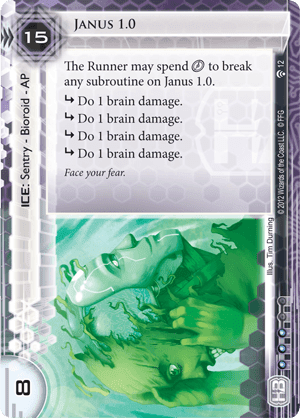

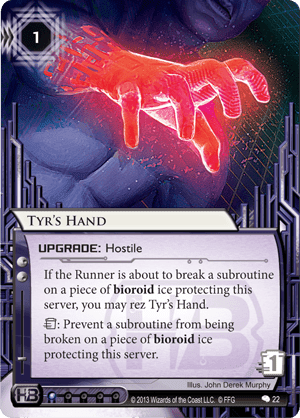
.png)



